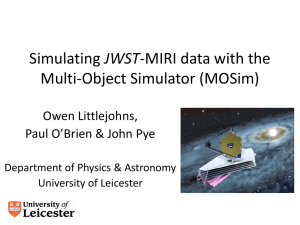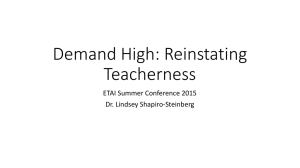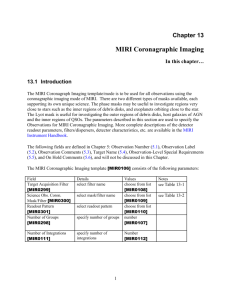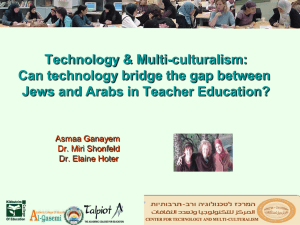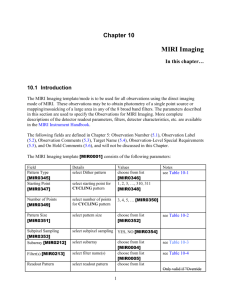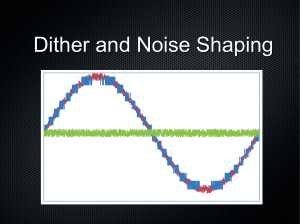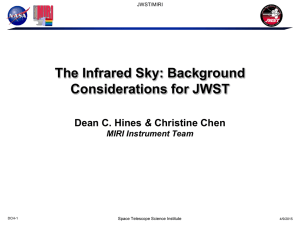TECHNICAL REPORT
advertisement
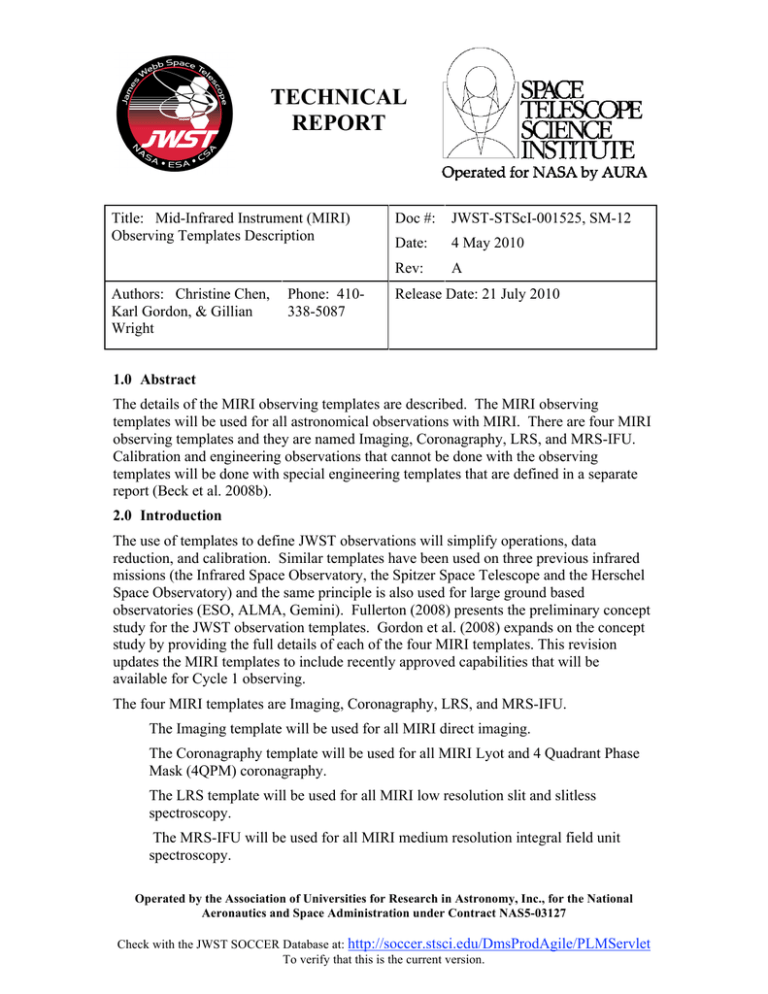
TECHNICAL
REPORT
Title: Mid-Infrared Instrument (MIRI)
Observing Templates Description
Authors: Christine Chen,
Karl Gordon, & Gillian
Wright
Phone: 410338-5087
Doc #:
JWST-STScI-001525, SM-12
Date:
4 May 2010
Rev:
A
Release Date: 21 July 2010
1.0 Abstract
The details of the MIRI observing templates are described. The MIRI observing
templates will be used for all astronomical observations with MIRI. There are four MIRI
observing templates and they are named Imaging, Coronagraphy, LRS, and MRS-IFU.
Calibration and engineering observations that cannot be done with the observing
templates will be done with special engineering templates that are defined in a separate
report (Beck et al. 2008b).
2.0 Introduction
The use of templates to define JWST observations will simplify operations, data
reduction, and calibration. Similar templates have been used on three previous infrared
missions (the Infrared Space Observatory, the Spitzer Space Telescope and the Herschel
Space Observatory) and the same principle is also used for large ground based
observatories (ESO, ALMA, Gemini). Fullerton (2008) presents the preliminary concept
study for the JWST observation templates. Gordon et al. (2008) expands on the concept
study by providing the full details of each of the four MIRI templates. This revision
updates the MIRI templates to include recently approved capabilities that will be
available for Cycle 1 observing.
The four MIRI templates are Imaging, Coronagraphy, LRS, and MRS-IFU.
The Imaging template will be used for all MIRI direct imaging.
The Coronagraphy template will be used for all MIRI Lyot and 4 Quadrant Phase
Mask (4QPM) coronagraphy.
The LRS template will be used for all MIRI low resolution slit and slitless
spectroscopy.
The MRS-IFU will be used for all MIRI medium resolution integral field unit
spectroscopy.
Operated by the Association of Universities for Research in Astronomy, Inc., for the National
Aeronautics and Space Administration under Contract NAS5-03127
Check with the JWST SOCCER Database at: http://soccer.stsci.edu/DmsProdAgile/PLMServlet
To verify that this is the current version.
JWST-STScI-001525
SM-12
The details of the four observing modes and operations of the MIRI arrays can be found
in Chen, Friedman, & Gordon (2010). The preliminary design of the MIRI templates can
be found in Fullerton (2008).
2.1
Basics of MIRI Readout Patterns
There are issues with terminology on how to designate how the detectors are read out and
the names for subsets of these readouts. For this document, readout patterns can be
subsets of the allowed readout mode parameters. The terminology needs to be revisited
to make it standard across JWST instruments as well as between different subsystems
(proposal/planning, scripts, pipeline, etc.).
Some definitions:
frame = single, non-destructive read of all the pixels in an array
group = combination of multiple frames on board the spacecraft to reduce the data
volume
integration = time between resets of the pixels (destructive read)
There are two standard readout patterns for the MIRI detectors: FastMode and
SlowMode. FastMode reads the full array every 2.775 seconds and SlowMode every
27.105 seconds (1 frame per group). Full frame observations with exposure times
greater than 105 seconds will be taken in SlowMode to reduce the data volume. Full
frame observations with exposure times greater than 5.55 seconds (2 FastMode groups)
and less than or equal to 105 seconds (38 FastMode groups) will be taken in FastMode
(Chen & Gordon 2010).
For long observations of bright sources or backgrounds, coaddition of FastMode
observations will be required to manage the data volume. This is the only mode where
such coaddition happens for MIRI. This mode is called FastMode Co-Addition and
allows for multiples of 4 frames to be coadded into a single group (other powers of 2 are
allowed, but 4 will likely be all that is needed). The shorthand for coadded readouts with
groups/integration = 2 to 10 (4 frames per group) is FASTGRPAVG. Ideally, the
transition to FASTMode Co-Addition should be determined based on the data recorder
usage of all of the instruments within a downlink period. However, the constraints
introduced by using scheduling to drive readout pattern decisions may be overly
complex. Therefore, we defer any decision on the transition to FASTMode to a WIT
working group that may provide similar advice to all of the instruments. The readout
patterns are summarized in Table 1
Table 1: Readout Pattern Details (per Integration)
Name
Full Frame Time Groups/Integration Min/Max Groups
SlowMode
27.105 sec
1
4/40
FastMode
2.775 sec
1
2/38
FASTGRPAVG 2.775 sec
4
2/10
Check with the JWST SOCCER Database at: http://soccer.stsci.edu/DmsProdAgile/PLMServlet
To verify that this is the current version.
-2-
JWST-STScI-001525
SM-12
2.2
Source Specification
The specification of the source position and brightness will be done in a manner
consistent between all the instruments on JWST. A draft of the information needed for a
fixed source is given by Fullerton (2008) and reproduced in Table 2 for completeness.
Additional entries will be required to specify “generic”, “offset” or “moving” targets.
Some of this information may be retrieved from exposure time calculator computations
(e.g. flux of the source in a specific MIRI band) and these details are expected to be
refined in a later study.
Table 2: Schematic Template Input for Source Description
Input
Details
Identification
Target Number
Target Name
Target Class
(Fixed, Generic, Moving, Offset)
Alternate Names
Position
Proper Motion
Reference Flux
Optional Information
2.3
Default
Target Type (astrophysical)
Target Description
RA (ICRS)
Dec (ICRS)
RA Uncertainty
Dec Uncertainty
RA PM
Dec PM
Epoch
Waveband or wavelength
Flux (magnitude)
Units
Uncertainty
Other Fluxes [multiple entries]
Radial Velocity
Parallax
Comments
Remarks
…
…
…
Programmatic reference
From a preferred catalog
Menu
…
[Optional]
Multiple entries permitted
Menu
Menu: depends on target type
…
...
…
…
0.1″
0.1″
0.0 ″/year
0.0 ″/year
…
…
…
…
…
…
…
0.0 ″
…
[default for ICRS]
[default for ICRS]
[units are TBD]
[units are TBD]
Many different possibilities
depending on target type
More information on spectral
energy distribution
In km/s or as a redshift
Text block
Special Requirements
Templates and sets of templates can have special requirements attached to them. A
possible set of special requirements is described in Fullerton (2008). Such special
requirements normally deal with specifying the orientation and/or time a template or set
of templates will execute. These special requirements are not restricted to templates from
a single instrument, but can include templates from multiple instruments. For example,
NIRCam and MIRI Imaging templates of a Kuiper Belt object could be grouped with a
special requirement that they be executed back-to-back to enable simultaneous near- and
mid-IR imaging of the object at the same rotation angle.
Check with the JWST SOCCER Database at: http://soccer.stsci.edu/DmsProdAgile/PLMServlet
To verify that this is the current version.
-3-
JWST-STScI-001525
SM-12
2.4
Parallel Science Observations
Parallel science observations using two or more instruments are not currently planned for
JWST.
At a future date, it may become possible to enable such parallel observations. Issues to
be overcome include managing the resulting data volume as well as determining how to
set up such observations to take data efficiently. The benefit of such parallel
observations would be an (possibly quite significant) increase in the amount of science
data taken by JWST. The nominal efficiency would also increase if efficiency is defined
as cumulative time all instruments take astronomical data versus the total amount of time
JWST is actively operating.
One possible way to enable parallel science observations is to enable only certain
combinations (e.g., MIRI and NIRCam imaging). Then a new template could be
constructed that would only be used for MIRI and NIRCam imaging and where the
operational parameters of both MIRI and NIRCam would be optimized to get good data
with both instruments in parallel (e.g., such operations may not be optimal for either
instrument, but they would both produce good data). This is an approach that has been
taken with the Herschel Space Observatory and PACS/SPIRE parallel mapping of
regions. Given that the observing tool will need to allow for post-launch modifications
and additions to the templates for each instrument (in case in-orbit checkout identifies
problems), the addition of new templates for parallel science does not need to be
considered further at this stage.
3.0 MIRI Imaging Template
The MIRI Imaging Template will be used for all direct imaging with MIRI. The inputs
for the MIRI Imaging Template are detailed in the following subsections and summarized
in Table 3.
3.1
Target Acquisition
Target acquisition is not needed for direct imaging with the FULL, BRIGHTSKY, and
SUB256 subarrays. Target acquisition is needed for direct imaging with the SUB128 and
SUB64 subarrays.
3.2
Filters
Any of the broadband filters (F560W, F770W, F1000W, F1130W, F1280W, F1500W,
F1800W, F2100W, & F2550W) can be used for direct imaging. Multiple filters each
with a different exposure time can be specified in a single template.
One other “filter” choice may also be allowed. This is the LRS prism and using it in
direct imaging mode would result in slitless LRS observations of all sources in the direct
imaging field-of-view. One science application of imaging with the prism is multi-object
spectroscopy since light from all objects in the field would be dispersed. The use of the
LRS prism in this way is a TBD and it would have significant implications on the
calibration pipeline. STScI currently does not have any plans to support data reduction of
imaging obtained with the LRS prism.
Check with the JWST SOCCER Database at: http://soccer.stsci.edu/DmsProdAgile/PLMServlet
To verify that this is the current version.
-4-
JWST-STScI-001525
SM-12
3.3
Readout Region (Subarray)
Any of the imaging subarrays (SUB64, SUB128, SUB 256, BRIGHTSKY, & FULL) can
be used for direct imaging (Chen, Rieke, & Gordon 2010). Currently, only one subarray
may be specified for each template (visit).
3.4
Readout Mode
FastMode and SlowMode readout modes are allowed for FULL frame observations, but
will be chosen automatically by the software based on the exposure time per integration
(see next section). Only the FASTMode readout mode is allowed for smaller subarray
observations.
3.5
Total Exposure Time per Dither Position
The user will specify the total exposure time desired per filter per dither position. This is
desired as it simplifies the input for the user to what an astronomer will be familiar with
and does not require the user to learn the specifics for each mode. The number of frames
(or groups) per integration and the number of integrations per exposure time will be
calculated by APT and displayed for the user. The final total exposure time will be
quantized in units of the minimum frame time for the specific readout mode (see Chen &
Gordon 2010 for details) and also displayed for the user. If the data volume of requested
FastMode observations is too high (limit TBD), the readout mode will be FastMode CoAddition. There will be a limit on the maximum exposure time allowed for any filter in a
single integration of 1084 seconds (40 SlowMode groups, TBR). The limit on the
maximum exposure time in a single integration will be smaller for the longer wavelength
filters as they will saturate on the telescope background in less than the maximum of
1084 seconds. For SlowMode observations, it may be useful to have a short cut to easily
specify a high dynamic range (HDR) set of two exposures. Such a HDR set would
include the shortest exposure time possible (5.52 sec = 2 groups in FastMode, TBR) in
addition to the requested total exposure time per dither. This would allow for the
brightest sources possible to be efficiently imaged along with faint sources. Only for
observations requesting exposure times long enough to trigger SlowMode observations
would benefit from this HDR mode.
3.6
Dither Pattern
For BRIGHTSKY and FULL subarray direct imaging observations, the user will be able
to select from two detector scale dither patterns (12-point Reuleaux and 311-point
Cycling patterns) that are optimized for self-calibration. Both patterns are available in
small, medium, and large sizes with small patterns preferred for shorter-wavelength
observations and larger patterns preferred for longer wavelength observations. The user
may specify the dither pattern and size desired for observations with each filter. The 311point Cycling pattern is designed to be flexible, allowing observers to select the initial
position and the number of dither offsets (with a minimum of 3 points) to be used, to
provide observations with arbitrary sky depths. The user may also combine a small 4point Parallelogram pattern with either the 12-point Reuleaux or 311-point Cycling
patterns to improve sub-pixel sampling. For direct imaging observations obtained with
smaller subarrays, the user must select the 5-point Gaussian dither pattern; they may or
may not combine this pattern with the small 4-point Parallelogram pattern (Chen 2010).
Check with the JWST SOCCER Database at: http://soccer.stsci.edu/DmsProdAgile/PLMServlet
To verify that this is the current version.
-5-
JWST-STScI-001525
SM-12
There may be special cases where no dither pattern (planet transits) will be required. The
MIRI Imaging template will provide an option for no dithering. If a user selects the no
dithering option, then APT should query the user to verify that no dither pattern is indeed
requested.
3.7
Mosaicking
Mosaicking of sources and regions larger than the MIRI Imaging field-of-view with
multiple filters is likely to be an often requested MIRI observation. To avoid stressing
the filter wheel (lifetime rotations), mosaics should be designed to use dithers (without
filter changes) as much as possible and almost full array offsets between mosaic positions
instead of (for example) taking a single exposure at each mosaic position with mosaic
positions with ½ array offsets.
As an example, a minimal mosaic would consist of mosaic positions with a 4 point dither
(to provide the necessary redundancy). At each mosaic position, the 1st filter would be
picked and the 4 exposures, 1 at each dither position, would be taken. Then the next
filter would be picked, and 4 more exposures taken. This would be repeated until all of
the requested filters had been used. Then the next mosaic position (0.95 of the array
width/height away) would be moved to (requiring a new guide star acquisition) and the
observations in all the filters would be repeated.
Using the above methodology, 1 min exposures, all 9 MIRI filters, and reasonable
assumptions on overheads, it will take approximately 1 hour per mosaic position to
acquire all the requested images. Using all 9 MIRI filters per mosaic position results in a
stress case for the largest number of filter steps per unit time. This means that it is
possible to mosaic 8760 different mosaic positions per year if MIRI were continuously
used and there were no other overheads. This would represent 105,120 filter steps. It is
unlikely that MIRI Imaging will take up a full year of the JWST science (this is a year
without other overheads). The MIRI filter wheel is qualified to 150,000 filter steps.
To avoid persistence, it is likely that it would be good to either move through the filters
from short to long wavelengths (to minimize the persistence of the background) or long
to short wavelengths (to avoid latents due to point sources). Determining which of these
sequences is best will need to be determined after the persistence/latent behavior is well
known. There may be some other optimal sequence possible based on the location of the
filters in the filter wheel. The final optimal sequence will be determined in a later study.
Check with the JWST SOCCER Database at: http://soccer.stsci.edu/DmsProdAgile/PLMServlet
To verify that this is the current version.
-6-
JWST-STScI-001525
SM-12
3.8
Tabular Summary
Table 3: Inputs to the MIRI “Imaging” Template
Input
Details
A. Source Specification:
See Table 1
A1. Target Acq. Source
Specification
See Table 1
Remarks
Can be the same as
the source.
B. Instrument Configuration:
Detector
Filters
Specify readout region
Specify filters
For each filter:
Specify Dither Pattern
Determine Readout Mode
Specify Exp. Time
Choose from menu
Choose from menu
Select dither
pattern from menu
[per dither step]
C. Observation Implementation:
Mosaic? [Y/N]
Special Requirements
If “Y”
If “Y”
Specify via generic form
Specify via generic form
4.0 MIRI Coronagraphic Imaging
The MIRI Coronagraphic Imaging Template will be used for all coronagraphic imaging
with MIRI. MIRI has one Lyot and three 4 quadrant phase mask (4QPM) coronagraphs.
The inputs for the MIRI Coronagraphic Template are detailed in the following
subsections and summarized in Table 4.
4.1
Target Acquisition
All MIRI coronagraphic observations require target acquisition. There are two target
acquisition procedures, one for Lyot observations and one for 4QPM observations
(Gordon & Meixner 2008b). The user is required to pick the filter through which to
perform the coronagraphic target acquisition. The available filters are F560W, F1000W,
F1500W and neutral density. The flux of the target acquisition source is required to
determine the target acquisition exposure time. This flux is either supplied by the user or
from the results of an ETC calculation (in other words, using the same method as for the
target object [section 2.2]).
4.2
Reference PSF Star
Most coronagraphic observations will require reference point-spread-function (PSF) star
observations. These reference observations are required to improve the cancellation of
the light from the central point source by allowing PSF subtraction. This is highly
desirable given that the JWST primary consists of multiple mirror segments that will
change their phasing with time. The small misalignment of the primary mirror segments
will cause non-symmetric residuals in coronagraphic observations. The reference star
observations will provide a snapshot of these residuals for subtraction. The reference star
Check with the JWST SOCCER Database at: http://soccer.stsci.edu/DmsProdAgile/PLMServlet
To verify that this is the current version.
-7-
JWST-STScI-001525
SM-12
observations can be taken before or after the target star observations, but should be taken
as close in time as possible to avoid changes in the residuals between the target and
reference star observations. In no circumstances should a re-phasing of the primary
mirror segments separate the target and reference star observations.
While there are science cases where reference PSF star observations may not be required
(e.g., bright debris disks or companions), the default should be to request/require
reference PSF star observations.
The reference PSF star observations are a duplicate of the target star observations, except
the user needs to be able to change the total exposure time requested. The same
coronagraphs will be used as the target star. All the observations (e.g. different
coronagraphs) of the target star should be done before moving to the reference stars (or
vice versa) to have the highest efficiency possible.
If observers are searching for planets or edge-on disks, then angular differential imaging
(ADI) has been used for some coronagraphic observations to self-subtract the central
PSF. In this case, the telescope is rolled, changing the angular offset of the putative planet
or disk relative to the diffraction artifacts. Subtracting observations obtained at two
different roll angles suppresses the point source speckles, improving the sensitivity to
faint companions or diffuse material. Unfortunately, JWST observations will be limited
to roll angles ±3° unless observations are widely separated in time; therefore, ADI will
not be an efficient method for PSF removal.
4.3
Coronagraph
The coronagraph to be used is specified by the user. The choice of which of the 4
coronagraphs to be used is specified by their associated filter F1065C, F1140C, F1550C,
and F2300C. Each coronagraph is uniquely associated with a specific filter and
commonly referred to by its associated filter. The F2300C coronagraph is the Lyot
coronagraph and the other three coronagraphs are 4QPM coronagraphs. It should be
possible for user to pick 1, 2, 3, or all 4 coronagraphs to be used for observations in the
template. This will increase the efficiency of the observations, as all the requested
observations of the target star should be carried out before doing the observations of the
reference PSF star (or vice versa).
While it is possible to use the Lyot coronagraph with any of the direct imaging filters
instead of the F2300C filter, this is non-optimal. The Lyot coronagraph has been
optimized for the F2300C filter and its use with other filters should only be considered if
the 4QPM filters fail, and so it is not offered as a user choice in the template. There may
be science cases where the use of other filters with the Lyot coronagraph is desired (e.g.,
debris disks). Before such use will be allowed, these other filters will need to be tested
(i.e. in cycle 1) to determine the performance in such nonstandard filters. Modeling of
these nonstandard filters with the Lyot coronagraph should also be done prior to launch to
inform the testing procedure.
4.4
Subarray
The specification of a particular coronagraph uniquely specifies the subarray region to be
used.
Check with the JWST SOCCER Database at: http://soccer.stsci.edu/DmsProdAgile/PLMServlet
To verify that this is the current version.
-8-
JWST-STScI-001525
SM-12
4.5
Readout Mode
Coronagraphic observations will only be made using FastMode.
4.6
Total Exposure Time
The user will specify the total exposure time desired. Dithers are not done for
coronagraph observations so this will be the total integration time desired. This is desired
as it simplifies the input for the user to what an astronomer will be familiar with and does
not require the user to learn the specifics for each mode. The number of frames/groups
per integration and the number of integrations per exposure will be calculated by the
software and displayed for the user. The final total exposure time will be quantized in
units of the minimum subarray time (see Beck 2008a for details) and also displayed for
the user. If the data volume of requested FastMode observations is too high (limit TBD),
the readout mode will be FastMode Co-Addition.
There will be a limit on the maximum exposure time allowed for any coronagraph in a
single integration of TBD seconds for the 4QPM and Lyot coronagraphs. This
corresponds to TBD and TBD FastMode groups with 0.228 and 0.323 sec per group for
the 4QPM and Lyot Coronagraphs, respectively. The limit on the maximum exposure
time in a single integration may be smaller for the longer wavelength filters as they will
saturate on the telescope background in less than the maximum integration time. The
maximum integration times for all the coronagraph/filters have been calculated using the
Rieke radmodel spreadsheet (0.75 of full well as saturation, full well = 200,000 e). The
F2300C coronagraph/filter has a maximum integration time of 56 seconds, which is much
smaller than the nominal allowed maximum integration time. All the other
coronagraphic/filters can have integration times up to ~1100 seconds without saturation
on the background.
4.7
Dither Pattern
Dithering is not desired or allowed for coronagraphic observations.
4.8
Tabular Summary
Table 4: Inputs to the MIRI “Coronagraphic Imaging” Template
Input
Details
Remarks
See Table 1
A. Source Specification:
B. Instrument Configuration:
Target Acq
Coronagraph
Specify filter
Specify filters
For each filter:
Specify Total Exp. Time
Choose from menu
Choose from menu
C. Observation Implementation:
Reference PSF Star
Special Requirements
If “Y”
If “Y”
Specify reference source details (A.)
Specify via generic form
Check with the JWST SOCCER Database at: http://soccer.stsci.edu/DmsProdAgile/PLMServlet
To verify that this is the current version.
-9-
JWST-STScI-001525
SM-12
5.0 MIRI Low-Resolution Spectroscopy
The MIRI Low-Resolution Spectrograph (LRS) Template will be used for all LRS slit
and slitless spectroscopy with MIRI. The inputs for the MIRI LRS Template are detailed
in the following subsections and summarized in Table 5.
5.1
Target Acquisition
Most LRS observations will require target acquisition. The accuracy of the wavelength
calibration and flux throughput depends on accurately placing the source in the slit. Most
observations will use the slit to reduce the amount of second order and minimize the sky
background; however, some observations of bright sources will be slitless. For example,
exo-planet transit observations will require very high photometric precision that can only
be obtained using slitless LRS. Target acquisition for LRS slit and slitless spectroscopy
will place the target in separate locations on the detector. For slit spectroscopy, the target
will be place behind the slit. For slitless spectroscopy, the target will be placed in the
Lyot Coronagraph field-of-view. The target acquisition procedure is described in Gordon
& Meixner (2008b). The user is required to pick the filter through which to perform the
LRS target acquisition. The available filters are F560W, F1000W, F1500W, & neutral
density. The flux of the target acquisition source is required to determine the target
acquisition exposure time. The target acquisition source can be the LRS observation
source (most of the time) or a separate source specifically chosen for target acquisition
(rare). This flux is either supplied by the user or from the results of an ETC calculation
(in other words, using the same method as for the target object [section 2.2]).
5.2
Subarray
All LRS slit observations are taken using full frames (1024x1024). This is needed as
sources imaged on other portions of the array may contaminate the LRS region (e.g.,
scattered light). Having data from the entire array available will enable such
contamination to be subtracted before extracting the LRS spectra (this was the case for
Spitzer/IRS ShortLow observations and the peakup arrays).
All LRS slitless observations are taken using the SLITLESSPRISM (68x512) subarray.
LRS slitless observations are designed to accommodate observations of transiting planet
host stars that are expected to be bright.
5.3
Readout Mode
FastMode and SlowMode readout modes are allowed, but will be chosen automatically
by the software based on the exposure time per integration (see next section).
5.4
Total Exposure Time
The user will specify the total exposure time desired per dither position. This is desired
as it simplifies the input for the user to what an astronomer will be familiar with and does
not require the user to learn the specifics for each mode. The number of frames/groups
per integration and the number of integrations per expoure will be calculated by the
software and displayed for the user. The final total exposure time will be quantized in
units of the minimum frame time for the specific readout mode (see Beck 2008a for
details) and also displayed for the user. If the data volume of requested FastMode
observations is too high (limit TBD), the readout mode will be FastMode Co-Addition.
Check with the JWST SOCCER Database at: http://soccer.stsci.edu/DmsProdAgile/PLMServlet
To verify that this is the current version.
- 10 -
JWST-STScI-001525
SM-12
There will be a limit on the maximum exposure time in a single integration of 1104
seconds (40 SlowMode groups, TBR).
5.5
Dither Pattern
Two dither patterns have been defined for LRS slit observations (Chen 2008).
The ‘Point Source/Staring’ dither pattern consists of two positions approximately 1/3 and
2/3 of the way along the slit. This allows for the two positions to be differenced to
remove the background and enables measurement of the point source only.
The ‘Extended Source/Maping’ dither pattern is a user-defined customizable grid of
dither positions. The observer may specify the number of slit positions in the directions
parallel and perpendicular to the slit and the angular offsets in each direction. All LRS slit
Extended Source dither patterns are subject to visit constraints; all LRS slit templates
must use the same guide star. If an observer would like to obtain larger LRS slit maps,
then separate LRS Extended Source observations should be mosaicked together.
If the ‘Extended Source/Mapping’ dither pattern is specified, then a separate, off source
pointing, specified by the observer, to measure the background (telescope and
astronomical) may be specified. If the off source position is within 1 arcmin, it should be
possible to take the off source data without acquiring a new guide star. The on and off
source observations should be done back-to-back to minimize variations in the
background (temporal variations in the telescope and zodiacal backgrounds).
Dithering is not desired for exoplanet transiting observations and will not be allowed for
LRS slitless observations.
5.6
Mosaicking
Mosaicking is possible and desirable with the LRS-Slit for regions larger than 1 arcmin.
It may be that the sensitivity of the MRS-IFU is better than that of the LRS-Slit at the
same spatial resolution. In this case filled maps would be better taken with the MRSIFU. Sparse maps with the LRS-Slit would likely still be faster than similar MRS-IFU
observations and so mosaicking with the LRS-Slit would still be scientifically useful.
Mosaicking is not desired or allowed for LRS slitless observations.
Check with the JWST SOCCER Database at: http://soccer.stsci.edu/DmsProdAgile/PLMServlet
To verify that this is the current version.
- 11 -
JWST-STScI-001525
SM-12
5.7
Tabular Summary
Table 5: Inputs to the MIRI “LRS” Template
Input
Details
Remarks
A. Source Specification:
See Table 1
A1. Target Acq. Source
Specification:
See Table 1
Can be the same as
the source.
Specify filter
Specify Exp. Time
Choose from menu
[per dither step]
B. Instrument Configuration:
Target Acq
Detector
C. Observation Implementation:
Slit? [Y/N]
Dither?
Mosaic?
Special Requirements
If “Slit”
If “Slit”
If “Y”
Select dither pattern
Specify via generic form
Specify via generic form
Choose from menu
Choose from menu
6.0 Medium-Resolution Integral Field Unit Spectroscopy
The MIRI Medium-Resolution Integral Field Unit (MRS-IFU) Spectroscopy Template
will be used for all MRS-IFU spectroscopy with MIRI. The inputs for the MIRI MRSIFU Template are detailed in the following subsections and summarized in Table 7.
6.1
Target Acquisition
Most MRS-IFU observations will require target acquisition. The accuracy of the
wavelength calibration and flux throughput depends on the accurate placement of the
source on the facets of the image slicer. The target acquisition procedure is described in
Gordon & Meixner (2008b). The user is required to pick the filter through which to
perform the target acquisition. The available filters are F560W, F1000W, F1500W, &
neutral density. The target acquisition source can be the MRS-IFU observation source
(most of the time) or a separate source specifically chosen for target acquisition (rare).
The flux of the target acquisition source is required to determine the target acquisition
exposure time. This flux is either supplied by the user or from the results of an ETC
calculation (in other words, using the same method as for the target object [section 2.2]).
6.2
Grating Positions
The MRS-IFU is constructed to take 4 discontinuous segments of spectra at a time in a
single exposure. To cover the entire 5-28 micron range, 12 such segments of spectra are
required. The details of the MRS-IFU 12 segments are given in Table 6. For a single
exposure, there are only 3 choices of 4 sets of segments to take. In other words, all the
short, medium, or long segments are taken simultaneously. In order to acquire a
continuous spectrum from 5-28 micron, three exposures are needed (one with the short,
one with the medium, and one with the long sub-band setting). Thus, the user can choose
any combination of the short, medium, and long sub-bands depending on their science
Check with the JWST SOCCER Database at: http://soccer.stsci.edu/DmsProdAgile/PLMServlet
To verify that this is the current version.
- 12 -
JWST-STScI-001525
SM-12
needs. It is expected that many science cases will require spectra over the entire
wavelength range and so an option to pick all of the 3 sub-bands should be the default.
Table 6: MRS-IFU spectral segments
FOV (arcsec) Slice width # slices Sub-band Range (micron)
IFU1A 3.7x3.7
IFU1B 4.5x4.5
IFU2A 6.1x6.2
IFU2B 7.7x7.9
6.3
0.18
0.28
0.39
0.64
21
17
16
12
Short
4.87-5.82
Medium
5.62-6.73
Long
6.49-7.76
Short
7.45-8.90
Medium
8.61-10.28
Long
9.94-11.87
Short
11.47-13.67
Medium
13.25-15.80
Long
15.30-18.24
Short
17.54-21.10
Medium
20.44-24.72
Long
23.84-28.82
Subarray
All MRS-IFU observations are taken using full frames (1024x1024).
The spectra for the MRS-IFU are recorded on the two spectrographic arrays. The direct
imaging array data could be saved to allow for precise spatial registration between
different dither positions. This will require picking a filter and exposure time for the
direct imager observations. It might be sufficient to choose a standard filter (e.g.,
F560W) and exposure time to ensure good quality measurements of a certain density of
stars. The other option is to allow the user to specify both, but this is likely non-optimal.
To manage data volume, only a relatively short exposure may be necessary with the
direct imager as compared to the MRS-IFU exposures that are likely to be fairly long in
comparison. This would require separate exposure times between the direct imager and
the MRS-IFU. The goal of this observation is not to take a standard MIRI Imaging
Template observation, but just a quick snapshot with the imager at each dither position to
allow for a higher quality IFU spectral cube to be built. The data volume should be
minimal, as only a short imaging exposure is likely needed. The filter and exposure time
for the imager will need to be determined from a later study.
As currently implemented, the observing scripts do not allow for the imager to be
operated in parallel to the MRS spectrographs. Thus, the imager exposure would have to
be taken prior to starting the spectrograph exposure. This would increase the pressure to
have a short exposure in the imager to make sure the efficiency is kept as high as
possible.
Check with the JWST SOCCER Database at: http://soccer.stsci.edu/DmsProdAgile/PLMServlet
To verify that this is the current version.
- 13 -
JWST-STScI-001525
SM-12
6.4
Readout Mode
FastMode and SlowMode readout modes are allowed, but will be chosen automatically
by the software based on the exposure time per integration (see next section).
6.5
Total Exposure Time
The user will specify the total exposure time desired per grating position per dither
position. This is desired as it simplifies the input for the user to what an astronomer will
be familiar with and does not require the user to learn the specifics for each mode. The
number of frames/groups per integration and the number of integrations per exposure will
be calculated by the software and displayed for the user. The final total exposure time
will be quantized in units of the minimum frame time for the specific readout mode (see
Beck 2008a for details) and also displayed for the user. If the data volume of requested
FastMode observations is too high (limit TBD), the readout mode will be FastMode CoAddition.
There will be a limit on the maximum exposure time in a single integration of 1100
seconds (40 SlowMode groups, TBR).
6.6
Dither Pattern
The MIRI MRS dither patterns are currently TBD, pending detailed instrument
characterization that will be obtained during FM testing. Two classes of dither patterns
will probably be offered. The MRS will obtain observations of the same FOV in four
wavelength channels simultaneously; however, each channel will possess a separate pixel
scale, slice width, and number of slices. (1) One MRS pattern will be optimized to obtain
improve sampling in the spatial direction for all four MRS channels simultaneously. (2)
A second MRS pattern will be optimized to obtain improved sampling in both the spatial
and spectral directions. Since the plate scale, slice width, and number of slices is different
for each of the channels, each channel will require a custom dither pattern to obtain
improved spatial and spectral sampling (Chen & Glasse 2009).
There may be special cases where no dither pattern (planet transits) will be required. The
MIRI MRS template will provide an option for no dithering. If a user selects the no
dithering option, then APT should query the user to verify that no dither pattern is indeed
requested.
In addition, a separate, off source pointing, specified by the observer, to measure the
background (telescope and astronomical) may be specified. If the off source position is
within 1 arcmin, it should be possible to take the off source data without acquiring a new
guide star. The on and off source observations should be done back-to-back to minimize
variations in the background (temporal variations in the telescope and zodiacal
backgrounds).
6.7
Mosaicking
Mosaicking is possible and desirable with the MRS-IFU. The mosaicking should be done
(if possible) with positions offset from each other by integer multiples of 0.97” (in x
dimension) and 0.09” (in the y dimension). This pattern may be seen as dithering as it
will only require a new guide star acquisition if the map is larger than 1 arcmin. But it is
likely there will be cases where regions larger than 1 arcmin are mapped in this fashion.
Check with the JWST SOCCER Database at: http://soccer.stsci.edu/DmsProdAgile/PLMServlet
To verify that this is the current version.
- 14 -
JWST-STScI-001525
SM-12
6.8
Tabular Summary
Table 7: Inputs to the MIRI “MRS-IFU” Template
Input
Details
A. Source Specification:
See Table 1
A1. Target Acq. Source
Specification:
See Table 1
Remarks
Can be the same as
the source.
B. Instrument Configuration:
Target Acq
Dispersers
Specify filter
Specify disperser (grating) position(s)
{short, medium, long, all}
For each disperser position:
Specify Exp. Time
Specify Dither Pattern
Detector
Choose from menu
Choose from menu
[per dither step]
Select dither
pattern from menu
C. Observation Implementation:
Dither?
Y
Mosaic? [Y/N]
Special Requirements
If “Y”
If “Y”
2 dither patterns possible (1 always
requred
Specify via generic form
Specify via generic form
7.0 Summary
The details of the four MIRI observing templates (Imaging, Coronagraphy, LRS, and
MRS-IFU) are given. These templates will be used for all astronomical observations
with MIRI.
8.0 References
Beck, T. 2008a, JWST-STScI-001439, “Preliminary Definition of Exposure Times in
JWST Templates”
Beck, T. 2008b, JWST-STScI-001522, “Preliminary Definition of Observing Templates
for JWST Engineering Activities”
Chen, C. H. 2008, JWST-STScI-001634, “The LRS Dither Pattern”
Chen, C. H. & Glasse, A. 2009, JWST-STScI-001871, “MIRI MRS Dither Patterns”
Chen, C. H. 2010, JWST-STScI-001657, “MIRI Imaging Dither Patterns” [Rev A]
Chen, C. H., Rieke, G. H. & Gordon, K. D. 2010, JWST-STScI-001757, “MIRI
Subarrays for Planetary Transits and Other Bright Targets” [Rev A]
Chen, C. H. & Gordon, K. D. 2010, JWST-STScI-001986, “Defining MIRI Exposure
Times and Related Parameters”
Chen, C. H., Friedman, S. D., & Gordon, K. D. 2010 “MIRI Operations Concept
Document” [Rev C]
Fullerton, A. 2008, JWST-STScI-001257, Rev A, “Preliminary Definition of Observation
Templates for JWST Science Programs”
Check with the JWST SOCCER Database at: http://soccer.stsci.edu/DmsProdAgile/PLMServlet
To verify that this is the current version.
- 15 -
JWST-STScI-001525
SM-12
Gordon, K. D. & Meixner, M. 2008a, JWST-STScI-000910, “Mid-Infrared Instrument
(MIRI) Operations Concept Document JPL D-25632”
Gordon, K. D. & Meixner, M. 2008b, JWST-STScI-001407, “Mid-InfraRed Instrument
(MIRI) Target Acquisition Strategies and Use Cases”
Check with the JWST SOCCER Database at: http://soccer.stsci.edu/DmsProdAgile/PLMServlet
To verify that this is the current version.
- 16 -
